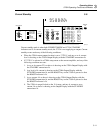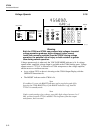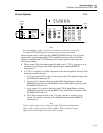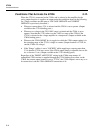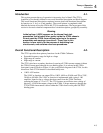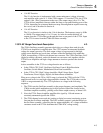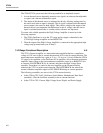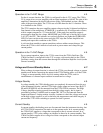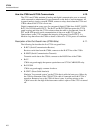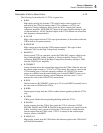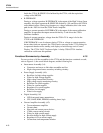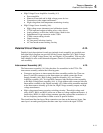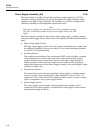
Theory of Operation
Overall Functional Description
4
4-5
• 11A DC Function:
The 11A dc function is implemented with a transconductance (voltage in/current
out) amplifier with a gain of -5. If the 5700A outputs -2V into the 5725A, the 5725A
output is 10A. (This is transparent to the user.) The output range is 0 to 11A. The
5725A delivers amplified current to either the front or rear panel binding posts of the
5725A, depending on an internal hardware setup. Reconfiguration requires removing
the covers, and is described in Section 6.
• 11A AC Function
The 11A ac function is similar to the 11A dc function. The frequency range is 40 Hz
to 10 kHz. The output range is 1 to 11A rms. As in the dc current function, all
outputs from the 5725A either go through the front or rear panel of the 5725A. Input
to the 5725A comes from the 5700A Oscillator assembly.
1100V AC Range Functional Description 4-3.
The 5700A Oscillator assembly generates the driving ac voltage, then sends it to the
5725A Power Amplifier for amplification. The 5725A returns an attenuated feedback
voltage for output correction. The final output voltage is kept accurate by the high
voltage sense amplifier and a real-time, software-controlled feedback loop within the
5700A, incorporating a 5700A ac/dc thermal rms converter. The 5700A Oscillator, DAC
(digital-to-analog converter), and ac/dc thermal rms converter work together with the
5725A Power Amplifier and high voltage attenuator circuits to produce the desired
output.
Active assemblies in the 5725A ac voltage function are as follows:
• In the 5700A: CPU, DAC, Oscillator, Oscillator Control, High-Resolution
Oscillator, Switch Matrix, Motherboard, Rear Panel assemblies.
• In the 5725A: CPU, High Voltage Amplifier, High Voltage Sense, Signal
Transformer, Power Supply, Digital, and Interconnect assemblies.
When an ac voltage in the 220 to 1100V range is selected, the 5700A calls the 5725A
amplifier and leaves its own high voltage amplifier dormant. The 5725A takes over the
1100V ac range automatically. The 5725A produces ac voltage in the following
sequence:
1. The 5700A sets the Oscillator assembly to the proper frequency and amplitude. The
5700A sets the initial amplitude using an 8-bit resistive hybrid dac located on the
Oscillator amplifier assembly, yielding an Oscillator output accuracy of about 0.5%.
2. Next, the 5725A Power Amplifier amplifies this signal by -100 and returns an
accurately attenuated signal to the 5700A.
3. The 5700A thermal sensor and adc (analog-to-digital converter) monitoring system
fine tune the Oscillator amplitude. The DAC assembly output is switched directly to
the Oscillator assembly, controlling the dac output amplitude. AC voltage calibration
constants stored in the 5725A determine the 5700A DAC voltage setting.



